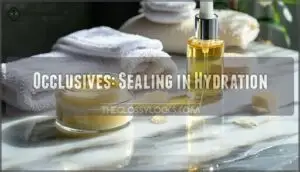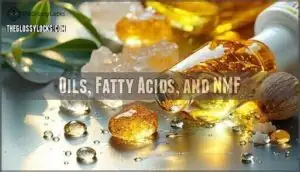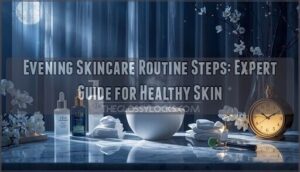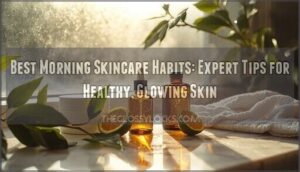This site is supported by our readers. We may earn a commission, at no cost to you, if you purchase through links.
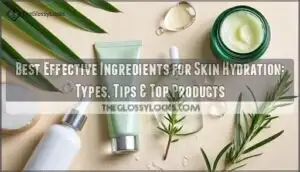
The truth is, your daily routine, the air you breathe, and the ingredients on your bathroom shelf all steer your skin toward radiance or discomfort. Finding the most effective ingredients for skin hydration doesn’t have to feel like guesswork; it’s about matching the right science to your skin’s unique story, so every layer feels its best.
Table Of Contents
Key Takeaways
- Humectants like hyaluronic acid and glycerin pull water into your skin, giving you a plumper, more hydrated feel.
- Ceramides and emollients repair and protect your skin barrier, helping lock in moisture and soothe dryness.
- Occlusives such as petroleum jelly and mineral oil seal hydration in, making them ideal for very dry or sensitive skin.
- Choosing ingredients that match your skin type and adjusting your routine for seasonal changes are key to keeping your skin comfortable and glowing.
What Causes Skin Dehydration?
Skin dehydration can sneak up on you for a lot of reasons, from your daily habits to shifts in the weather.
The truth is, your age and even your unique skin type play a part, too.
Let’s take a closer look at what’s working against your skin’s natural moisture.
Common Lifestyle and Environmental Factors
Long showers, low daily water intake, and urban air pollution are all common thieves of your skin’s hydration. Everyday choices can quietly damage your skin barrier, leading to dryness and increased transepidermal water loss. It’s also important to note that alcohol consumption dehydrates, impacting overall hydration levels.
Pay attention to how these factors work together:
- Climate effects from cold, dry air or indoor heating
- Pollution’s impact on skin moisture
- Habits like hot bathing or excess alcohol
Impact of Age and Skin Type
Maybe you’ve noticed skin feeling drier or less resilient as the years pass. That’s no accident. Aging skin hydration falls as your skin’s barrier weakens, especially after age 50.
Different skin types—think oily, dry, or combination—each face unique hydration hurdles. Structural changes influence how much moisture you keep, so antiaging routines matter more with time.
Measuring skin capacitance levels can help assess hydration.
Signs Your Skin is Lacking Hydration
If your face suddenly looks dull or feels tighter than usual, your skin is probably trying to tell you it’s thirsty. Dryness symptoms like flakiness, increased sensitivity, or even redness crop up when your skin barrier isn’t holding on to moisture.
Listen for other clues—persistent skin tightness or a parched, dehydrated look—because hydrated skin simply glows.
Types of Moisturizing Ingredients Explained
Not all moisturizers work the same way, and some are a better fit for your skin than others. Understanding what each does will help you find what works best for your routine.
Here’s a quick look at the main types of ingredients you’ll see on labels.
Humectants: Moisture-attracting Agents
Ever wonder how your skin drinks up moisture from the air, like a thirsty sponge on a humid day? Humectants—think hyaluronic acid and glycerin—work by pulling water into your skin. Here’s what you’ll notice:
- Dewy, plump texture
- Softer, more flexible skin
- Reduced tightness after application
Choosing the right ingredient combinations and application techniques matters.
Emollients: Smoothing and Softening
When your skin feels rough or dull, a touch of emollient can smooth things over like a fresh coat of paint on weathered wood. Emollients—like shea butter, squalene, fatty alcohols, and cocoa butter—restore your lipid barrier, boost skin smoothness, and offer dryness relief.
Let’s break it down:
| Emollient Type | Emollient Benefits | Common Product Formulation |
|---|---|---|
| Shea Butter | Skin Smoothness | Creams, Balms |
| Squalene | Dryness Relief | Serums, Oils |
| Fatty Alcohols | Lipid Barrier | Lotions, Creams |
| Cocoa Butter | Softening | Body Butters, Balms |
Occlusives: Sealing in Hydration
Occlusives—like petrolatum, beeswax, and dimethicone—work by forming a protective seal over your skin barrier. That’s the secret behind their occlusive benefits: they block water from escaping.
For best results, apply them last in your routine. With safe ingredients and mindful application techniques, you’ll help your skin weather dry environments without feeling greasy or weighed down.
Oils, Fatty Acids, and NMF
While oils like argan and evening primrose absorb quickly, boosting hydration by up to 59% within an hour, fatty acids repair your lipid barrier and lock in moisture.
The Natural Moisturizing Factor (NMF) combines amino acids, urea, and lactic acid—key for attracting water.
Clinical formulations blend these ingredients, ensuring your skin stays supple, protected, and comfortable.
Best Humectants for Skin Hydration
Humectants are the secret behind skin that looks fresh and feels comfortable. If you’re wondering which ingredients truly make a difference, you’re in the right place.
Let’s take a closer look at the best options for keeping your skin hydrated.
Hyaluronic Acid and Its Unique Benefits
Hyaluronic acid (HA) is a powerhouse humectant, drawing moisture into your skin and plumping it from within.
HA benefits go beyond hydration—it aids skin repair and smoothness. Whether you’re applying a serum or moisturizer, HA application helps boost your skin’s natural glow.
Compared to glycerin, HA synthesis offers deeper hydration, with minimal side-effects for most users.
Glycerin for Deep, Lasting Moisture
Glycerin benefits go beyond just hydration—it helps your skin stay soft, smooth, and comfortable all day. With the right glycerin concentration, you’ll notice less dryness and tightness.
Pairing glycerin with other humectants, like hyaluronic acid, boosts its effect. Most moisturizers use plant-based glycerin sources, and side-effects are rare, making it a safe bet.
Aloe Vera and Natural Humectants
If you’re craving a gentle boost of hydration, few things feel as soothing as a swipe of aloe or nature’s own moisture magnets. Aloe Vera offers cooling relief and bolsters your skin’s Natural Moisturizing Factor (NMF). For practical, sustainable hydration, try:
- DIY aloe application
- Natural humectants like honey
- Hydrating plant extracts
- Moisturizing ingredients from eco-friendly sources
Sugar and Other Emerging Ingredients
Looking for something beyond aloe? Sugar-based hydration agents, like xylitylglucoside and Aquaxyl, are changing the game. These emerging humectants boost your Natural Moisturizing Factor (NMF), support amino acids and PCA, and even help with anti-glycation. Pair them with botanical extracts for smoother, healthier skin—plus, market growth shows everyone wants in.
| Sugar | Botanical Extracts | NMF Support |
|---|---|---|
| XAX | Blue Daisy | PCA |
| Aquaxyl | Pomegranate | Amino Acids |
| Glucose | Ginseng | Ceramides |
Top Emollients and Occlusives to Try
When your skin needs extra comfort and protection, emollients and occlusives step in to help. These ingredients work behind the scenes to smooth, soften, and seal in moisture.
Let’s look at some of the top picks worth considering.
Ceramides for Barrier Repair
A healthy skin barrier relies on ceramides, the moisturizing ingredients your skin naturally craves. Clinical efficacy shows ceramide creams boost hydration by over 30% in days, while TEWL reduction helps lock in moisture for those with atopic dermatitis. With an impressive safety profile, correct ceramide ratios support barrier repair, making ceramides essential for skin hydration and care.
- Support skin barrier function
- Reduce transepidermal water loss (TEWL)
- Relieve dryness in atopic dermatitis
- Clinically proven hydration benefits
- Safe for sensitive skin
Squalane for Non-greasy Nourishment
While ceramides help fortify your skin’s barrier, squalane steps in to nourish and soften without leaving behind any greasy residue.
Squalane benefits anyone seeking lightweight, hydrating care—especially if you have oily skin or dislike heavy creams. Look for squalane sourced from olives, and layer it over your favorite moisturizing ingredients for boosted skin hydration and care.
Petroleum Jelly and Mineral Oil
When you want a simple way to lock in moisture, petroleum jelly and mineral oil are tried-and-true staples that act like a protective shield over your skin.
- Occlusive benefits: They seal in hydration and prevent water loss.
- Safety concerns: Some worry about petrolatum purity and environmental impact.
- Comedogenicity debate: Vaseline Petroleum Jelly is generally non-comedogenic, but product variations matter.
Plant-based Oils and Butters
Although your skin’s thirst for hydration might seem complicated, plant-based oils and butters offer a gentle, natural way to nourish and protect without weighing you down. For example, argan oil and grape seed oil deliver antioxidants, while shea and cocoa butter smooth rough patches.
Check out the table below for practical details:
| Oil Benefits | Butter Types |
|---|---|
| Argan, Macadamia | Shea, Cocoa |
| Extraction methods | Sustainable sourcing |
| Evening primrose, Sunflower | Product formulation |
Top 4 Dermatologist-Recommended Hydration Products
With so many choices out there, it’s easy to feel unsure about what actually works. Dermatologists often return to a few trusted basics for keeping skin hydrated.
Here are four that keep popping up in expert recommendations.
La Roche-Posay Gentle Cleanser for Sensitive Skin
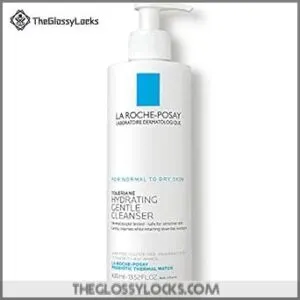
For anyone whose skin feels like it’s walking on eggshells, La Roche-Posay’s Gentle Cleanser offers comfort and care without the sting or fuss.
Made with prebiotic thermal water, niacinamide, and ceramide-3, this hydrating, fragrance-free formula leaves sensitive skin feeling clean and soothed.
While it won’t tackle heavy makeup, it shines for daily moisturizing, hydrating, and gentle cleansing.
CeraVe Moisturizing Cream for Dry Skin
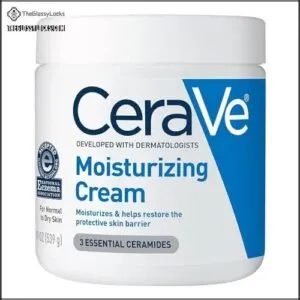
Even after a long day, there’s something instantly comforting about smoothing on a rich layer of CeraVe Moisturizing Cream. Thanks to its ceramide technology and a velvety, fragrance-free texture, you get:
- 24-hour dry skin relief
- Skin barrier repair with three ceramides
- Non-comedogenic ingredient safety
- Gentle hydration for sensitive skin
- Science-backed moisture that really lasts
Vaseline Petroleum Jelly Original
Think of Vaseline Petroleum Jelly as your skin’s protective raincoat—clinically proven to heal dryness and lock in moisture when nothing else seems to work. Its occlusive properties seal in hydration, offering dry skin relief overnight.
Petrolatum’s versatility means you can use it on minor cuts, cracked heels, or windburn. For cost effectiveness and straightforward moisturizing, it’s tough to beat.
Aquaphor Healing Ointment Dry Skin
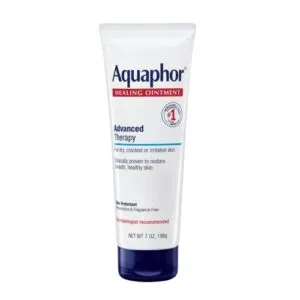
Ever wondered what it feels like to wrap your skin in a protective blanket that heals, soothes, and shields from the elements all at once?
Aquaphor Healing Ointment delivers just that, thanks to occlusive benefits from petrolatum and emollients like glycerin and bisabolol. Apply a thin layer on dry skin or lips—many users swear by its gentle, multi-purpose relief.
How to Choose The Right Ingredients for You
Finding the right ingredients for your skin isn’t always straightforward. Your skin type and lifestyle play a big role in what works best.
Before you pick your next product, think about these factors.
Identifying Your Skin Type and Needs
Figuring out your skin type is a bit like finding the right pair of shoes—comfort, fit, and personal needs make all the difference. Think about how your skin reacts to weather, stress, and products.
Take a skin type quiz, notice environmental impact, and stay mindful of lifestyle adjustments, product sensitivity, or seasonal changes that reveal if you’re dealing with dehydrated, oily, or dry skin.
Dermatologist Tips for Building a Hydration Routine
Once you’ve spotted your skin’s real needs, a dermatologist-approved hydration routine falls into place. Start with a gentle cleanser, follow with Product Order—using Layering Techniques to lock in moisture—then top with a barrier-repair cream.
Tailoring your routine to your specific needs and adjusting it with the seasons are key steps in transforming a basic regimen into genuine relief for dry skin that actually lasts.
Considering how your daily habits affect your skin further enhances this transformation, ensuring lasting results.
Common Mistakes to Avoid
Of course, even the best routine can stumble if you miss a few common pitfalls along the way. Over-exfoliating strips your skin’s defenses, and ignoring ingredients or picking the wrong products leads to the opposite of hydrated skin—cue more dryness.
Hot showers might feel great but rob your skin of moisture, and skipping SPF leaves your skin care efforts half-finished.
Frequently Asked Questions (FAQs)
Can you layer hydration ingredients with other actives?
You can layer hydrating and moisturizing ingredients with actives, but watch for active ingredient conflicts. Start with humectants, then actives, and finish with occlusives.
Sensitive skin concerns? Monitor product absorption rates to avoid irritation in your skincare routine.
How long does it take to see results?
Immediate vs. long-term results depend on ingredient absorption rate, your hydration level baseline, and consistent application impact.
Most see plumper, hydrated and glowing skin in days, while skin barrier function and individual skin variation shape lasting change.
Are hydrating ingredients safe for sensitive skin?
Hydrating and moisturizing ingredients can be safe for sensitive skin, but ingredient irritation potential varies. Patch testing is essential, and dermatologist guidance helps navigate formulation considerations and long-term effects, especially for those with underlying skin conditions.
Do hydration ingredients cause breakouts or acne?
Spotting breakouts after using new skincare ingredients? Ingredient comedogenicity and pore-clogging potential matter. Some formulas can trigger acne or skin purging, especially on oily skin.
Choose non-comedogenic products suited to your skin type and conditions.
Should you adjust hydration routines seasonally?
Absolutely, routine adjustments help your skin adapt to changing weather. Winter dryness calls for richer formulas, while summer oiliness benefits from lighter products.
Seasonal ingredient swaps, like humectants or emollients, can make your skincare routine more effective.
Conclusion
Worried that finding effective ingredients for skin hydration means endless trial and error? It’s simpler than it seems—when you understand your skin’s needs, the right choices become clear.
Whether you reach for hyaluronic acid, ceramides, or nourishing oils, each ingredient plays a role in restoring comfort and glow. Trust your skin’s signals, and remember: a personalized routine is the secret to lasting hydration.
Your healthiest skin isn’t a mystery—it’s a story you can write every day.
Healthy skin isn’t a mystery—it’s a story you write every day through your choices
- https://pmc.ncbi.nlm.nih.gov/articles/PMC8322246/
- https://jddonline.com/oral-hyaluronic-acid-supplement-efficacy-in-skin-hydration-elasticity-and-wrinkle-depth-reduction/
- https://www.doctormedica.co/blog/top-30-facts-you-should-know-about-hyaluronic-acid
- https://www.e-ajbc.org/m/journal/view.php?number=640
- https://cosmoderma.org/clinical-evaluation-of-a-topical-ceramide-lotion-on-skin-hydration-and-skin-barrier-in-healthy-volunteers-with-dry-skin/



